Each May, Haitian Heritage Month offers us a vital opportunity to celebrate the rich history, culture, and contributions of Haitian people across the globe. As educators and families, it’s essential that we intentionally uplift a diverse mix of voices—balancing stories from both men and women, and especially emphasizing people of color whose accomplishments have often been devalued or ignored. Haitian Heritage Month was first celebrated in Boston in 1998 and has since expanded across the United States. It grew out of Haitian Flag Day (May 18), a cherished holiday in Haiti, and now honors Haiti’s pivotal role in world history as the first Black republic and the second independent nation in the Western Hemisphere.
By sharing the stories of Haitian and Haitian American authors, we help change stigmas, offer authentic representations, and foster a deeper understanding of the strength, struggles, and beauty of Haitian identity—both past and present. Below are seven children’s books written by authors of Haitian descent that bring history, resilience, and pride alive for young readers.
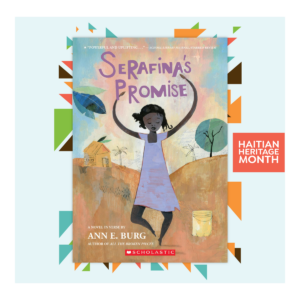 1. Serafina’s Promise by Ann E. Burg
1. Serafina’s Promise by Ann E. Burg
Find it on Amazon
Serafina’s Promise follows a young Haitian girl who dreams of becoming a doctor despite the hardships she faces, including poverty, natural disasters, and the complexities of daily life in Port-au-Prince. Written in verse, the story captures the vibrancy and resilience of Haitian culture.
Ann E. Burg, though not Haitian herself, deeply researched Haitian culture and collaborated with Haitian consultants to authentically portray Serafina’s world.
This book helps readers understand the everyday challenges faced by Haitian children and highlights the importance of education, family, and perseverance. It can inspire classroom discussions about the power of dreams, coping with natural disasters, and building community resilience. Students could create personal “dream maps” connecting their own aspirations to historical and sociological contexts.
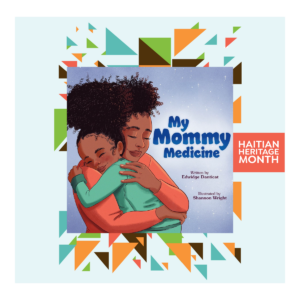 2. My Mommy Medicine by Edwidge Danticat
2. My Mommy Medicine by Edwidge Danticat
Find it on Amazon
In this sweet picture book, a young girl describes the many “medicines” her mother uses to help her feel better—hugs, kisses, laughter, songs, and storytelling—showing love’s power to heal.
Edwidge Danticat, born in Haiti and raised partly in the United States, is one of the most acclaimed Haitian American writers today. Her background lends deep authenticity to her depictions of familial bonds and emotional resilience.
This story provides a beautiful window into Haitian family dynamics, emphasizing emotional well-being and the nurturing role of mothers. It can launch classroom projects on emotional literacy, cultural understandings of caregiving, and writing “medicine lists” to promote well-being strategies among students.
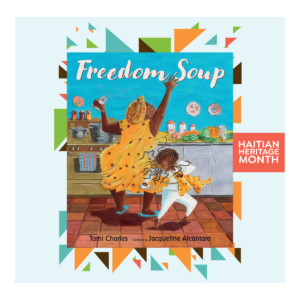 3. Freedom Soup by Tami Charles
3. Freedom Soup by Tami Charles
Find it on Amazon
Freedom Soup tells the story of Ti Gran teaching her granddaughter Belle how to make a traditional New Year’s soup, Joumou, while sharing the history of Haiti’s revolution against French colonizers.
Tami Charles, a former teacher and Haitian American author, brings her heritage to life with vibrancy and heart, making complex history accessible to young audiences.
The book allows students to connect food, culture, and resistance in powerful ways. Teachers can create interdisciplinary projects connecting culinary arts, history, and social justice—such as cooking demonstrations, researching other cultural food traditions tied to liberation, and making “freedom recipe books.”
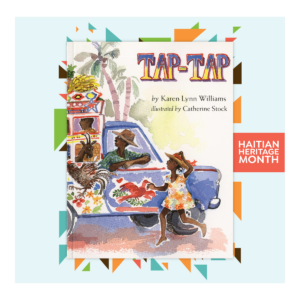 4. Tap Tap by Karen Lynn Williams and Catherine Stock
4. Tap Tap by Karen Lynn Williams and Catherine Stock
Find it on Amazon
In Tap Tap, a young girl named Sasifi dreams of riding a colorful Haitian bus—the “tap tap”—rather than walking to market. When she finally does, it turns into an unforgettable experience of independence and joy.
Karen Lynn Williams spent years living and working in Haiti, giving her insight into the everyday beauty and struggles of Haitian life.
This book captures Haiti’s vibrant street culture and helps readers understand transportation challenges and community life in rural Haiti. Students can engage in sociology projects exploring access to transportation worldwide, designing their own “tap tap” buses, or writing narratives about everyday heroes in their communities.
 5. Eight Days: A Story of Haiti by Edwidge Danticat
5. Eight Days: A Story of Haiti by Edwidge Danticat
Find it on Amazon
Eight Days tells the story of Junior, a young boy trapped under rubble for eight days after the 2010 Haiti earthquake. Through his imagination, he survives, dreaming of the life and loved ones waiting for him.
Danticat’s personal connections to Haiti and her experience witnessing the aftermath of the earthquake give this story its heartfelt power and realism.
This moving story can open conversations about trauma, hope, and community rebuilding after disasters. Students can research how communities around the world recover from natural disasters and create “resilience plans” for their own communities, integrating history, psychology, and emergency preparedness.
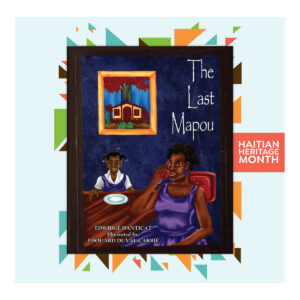 6. The Last Mapou by Edwidge Danticat, illustrated by Edouard Duval-Carrié
6. The Last Mapou by Edwidge Danticat, illustrated by Edouard Duval-Carrié
Find it on Amazon
In The Last Mapou, a girl named Bijou protects the last mapou tree in her neighborhood, a tree that symbolizes wisdom and heritage. This lyrical tale beautifully blends environmental stewardship with cultural pride.
Danticat again draws on Haitian symbolism and spirituality to craft a story rooted deeply in Haitian tradition.
This book can inspire students to explore the importance of cultural and environmental preservation. It supports projects on local environmental activism, mapping cultural landmarks in students’ own communities, and learning how indigenous and local traditions intersect with ecology.
Conclusion
Using these seven powerful books in your classroom or home doesn’t just honor Haitian Heritage Month—it lays the foundation for a more inclusive, empathetic, and historically rich learning environment year-round. These stories offer windows into Haiti’s enduring spirit, beautiful culture, and the extraordinary contributions of Haitian men and women throughout history.
Let’s celebrate Haitian voices in May and throughout the school year through reading, discussion, and action. Their stories deserve to be known, honored, and woven into the fabric of our classrooms, our communities, and our collective history.
You can continue to honor the contributions of all people by bringing Youth Empowered Stewardship to your school. Youth Empowered Stewardship (YES) is an innovative and experiential learning process. YES activates and sustains authentic partnerships between adults and students leading to compelling, sustainable, vibrant communities. Facilitators foster multi-generational collaboration through music, movement, and visual arts to address complex educational challenges. Drive continuous improvement with this asset-based, solution-oriented process.



